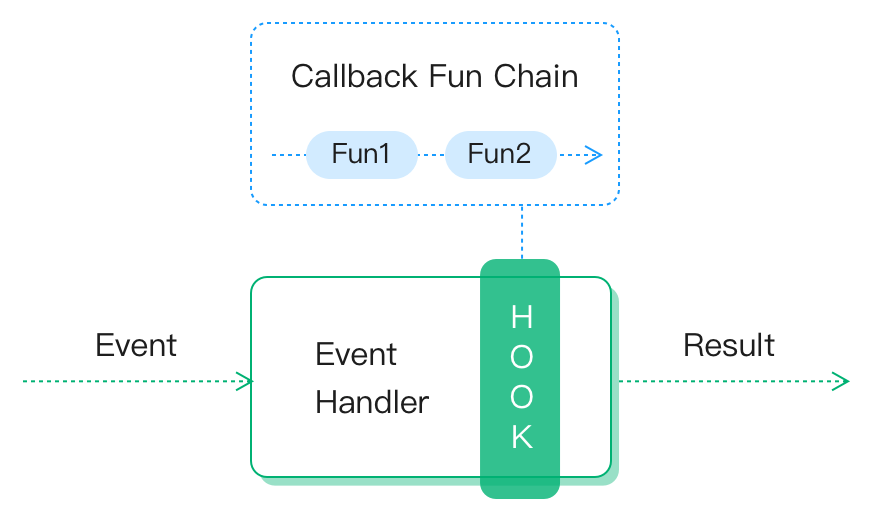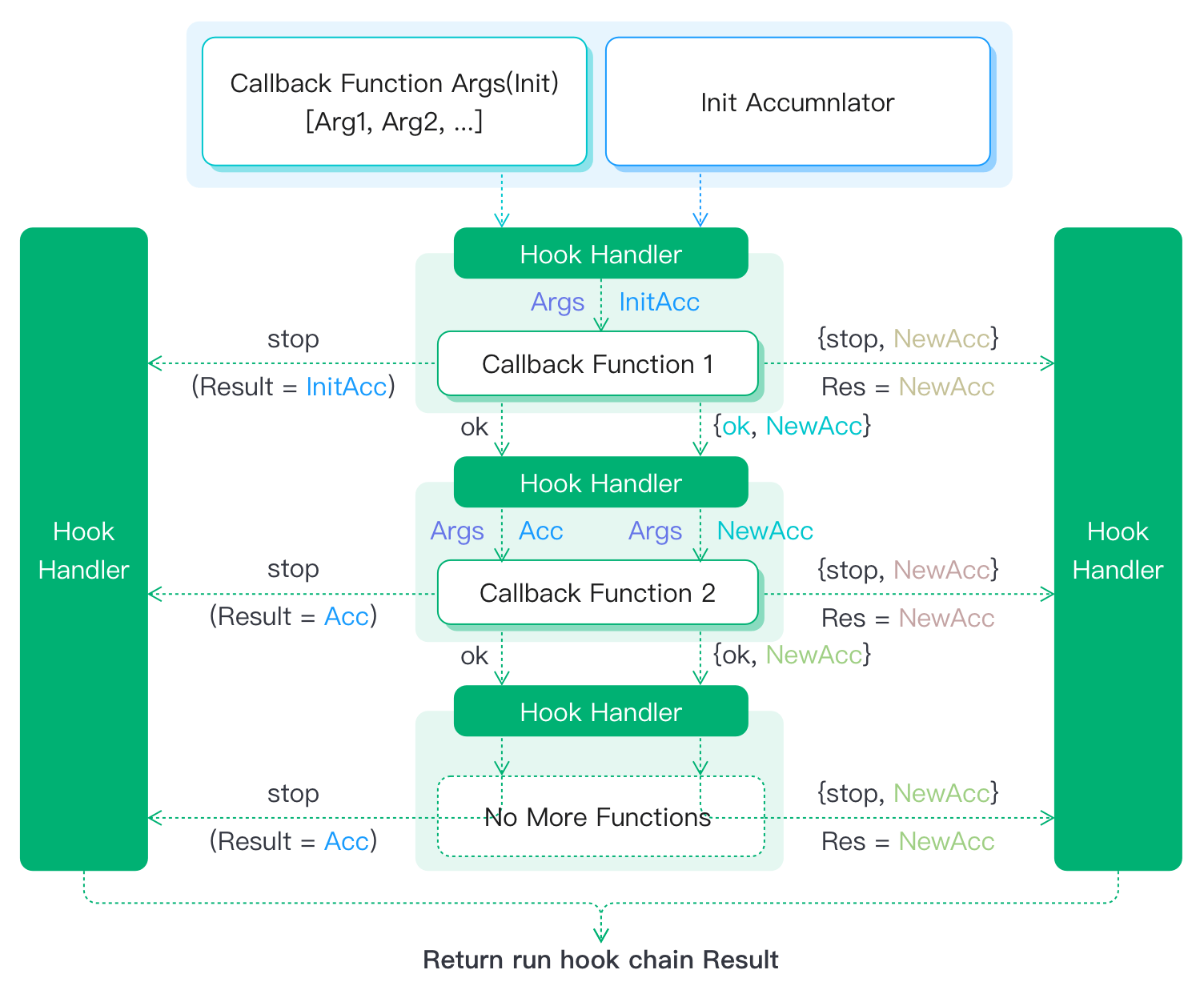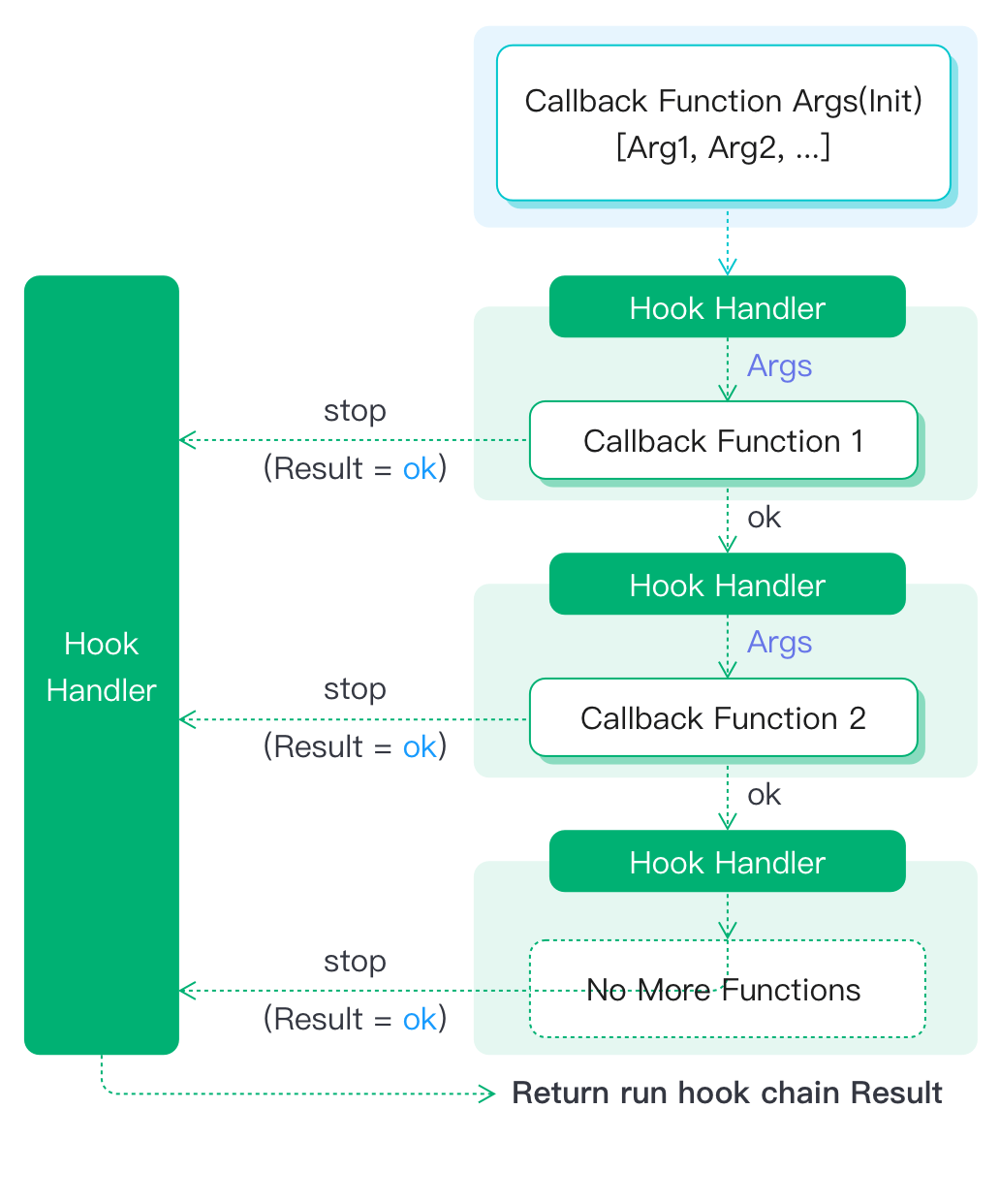Hooks
Hooks is an extension mechanism that lets you use state and other React features without writing a class.
EMQX also supports using Hooks to modify or extend system functions by intercepting function calls, message passing, and event passing between modules.
How It Works
For a system without adopting the Hooks mechanism in their system, the entire event processing flow (from the input of the event to the handler and the result) is invisible and cannot be modified.
However, if we add a HookPoint to mount functions during the process, external plugins can mount multiple callback functions to form a call chain. Then, the internal event processing can be extended and modified.

Several EMQX functions are implemented using the hook feature:
- Use the hook system to perform multi-step streaming processing (encoding/decoding, etc.) of messages
- Caching messages at message publishing time as per the configuration
- Use the hook-blocking mechanism to postpone message publishing
The authentication/authorization commonly used in the system is implemented according to this logic. Take the Multilingual extension as an example:
When only the Built-in Database authentication is enabled, according to the processing logic of the event (see figure above), the logic of the authentication module at this time is:
- EMQX receives the user's authentication request (Authenticate);
- EMQX executes the hook of the authentication event with
ClientInfoand the defaultAccIn.
%% Default AccIn
{ok, #{is_superuser => false}}- Call back to the
emqx_exhookmodule, assume this authentication is valid, and get allow, is_superuser result.
%% AuthNResult
{ok, #{is_superuser => true}}- Return Authentication succeeded, and the client will successfully access the system as a superuser.

Therefore, Hooks can greatly enhance the flexibility of EMQX. If we want to customize EMQX behaviors, we no longer need to modify the core code and only need to hook a function on HookPoint that EMQX provided on the specific location.
During this whole process, you only need to pay attention to:
- Location of HookPoint: Including its role, timing of execution, and how to mount and cancel mount.
- Implementation of callback function: including the number of input parameters, role, data structure of the callback function, and the meaning of the returned value.
- Mechanism of callback function execution on the chain: including the order in which callback functions are executed, and how to terminate the execution of the chain in advance.
If you used hooks in the development of the extension plugin, you should be able to fully understand these three above points, and try not to use blocking functions inside the hooks, which will affect system throughput.
Callback Functions Chain
There may be multiple plugins on a single HookPoint that need to care about the event and perform the corresponding operation, so there may be multiple callback functions on each HookPoint.
We call this chain composed of multiple callback functions executed sequentially Callback Functions Chain.
Callback Functions Chain is Currently implemented according to the concept of Chain-of-Responsibility. In order to satisfy the functionality and flexibility of the hook, it has the following attributes:
- Ordered: The callback functions on the Callback Functions Chain must be executed in a certain order.
- In Parameter: There must be one/some initialization parameters and, optionally, a cumulative value for modification by the Callback Functions Chain.
- Output Result: Each function in the chain must have an output, and
okshould be used as the function return value for callback functions that do not care about the result of execution. For example, in a notification class event, "A client has successfully logged in" does not require a return value. - Transitive: The result of callback functions in the chain is transitive. And to allow more flexibility in the use of hooks, we have designed two modes of handling the return values of callback functions in the chain.
- Result Transitive
It means that each callback function in the chain accepts the entry of the chain, and the return of the previous callback function (which can be interpreted as a cumulative value) as arguments. Until the last function, the return value of the last function is then the return value of the whole chain. Specially, the chain is called with an initial value for the cumulative value to be used by the first callback function in the chain. - Result Transparent
Each function in the chain only cares about the chain's entry, and will ignore the return value of the previous callback function. And the chain will have a fixed return value ofok.
This is actually a special case of the first type of Result Transitive. That is, the initial accumulation value isok, and each callback function in the chain only cares about the incoming parameters of the chain and keeps the accumulation value asokunchanged.
Most of notification event follows this logic. So that we provide the general Callback Functions Chain execution module.
- Result Transitive
- Callback Functions Chain needs to allow the functions with it to terminate the chain in advance and ignore this operation.
- Termination in advance: After the execution of this function is completed, the execution of the chain is directly terminated. All subsequent callback functions on the chain are ignored.
For example, an authentication believes that such clients do not need to check other authentication plugins after they are allowed to log in, so they need to be terminated in advance. - Ignore this operation: Do not modify the processing result on the chain, and pass it directly to the next callback function.
For example, when there are multiple authentication plugins, an authentication plugin believes that such clients do not belong to its authentication scope, and it does not need to modify the authentication results. This operation should be ignored and the returned value of the previous function should be passed directly to the next function on the chain.
- Termination in advance: After the execution of this function is completed, the execution of the chain is directly terminated. All subsequent callback functions on the chain are ignored.
Therefore, we can obtain two program flow diagrams for the execution chain based on the two ways of handling the return value of the callback function on the chain.
Result Transitive

The meaning of the figure is:
- A total of three callback functions are registered on the chain in the figure,
Fun1Fun2Fun3, which are executed in the order indicated - The callback function execution order is determined by the priority, and the same priority is executed in the order of mounting
- The input parameters of the chain are read-only
Argsand the parameterInitAccfor function modification on the chain. - Regardless of how the execution of the chain is terminated, the chain always returns a value, which depends on the return form.
- The callback function returns with:
ok: ignore this operation, continue the chain execution with read-onlyArgsandAccreturned by the previous function{ok, NewAcc}: perform some operations, modify Acc content, continue chain execution with read-onlyArgsand newNewAcc
- The callback function also returns with:
stop: Stop the transfer of the chain and immediately return the result ofAccfrom the previous function{stop, NewAcc}: it means to stop the transfer of the chain and immediately return the result ofNewAccfrom this modification
- The callback function returns with:
Result Transparent

Comparing this with the first execution mode, you can see that the execution mode that ignores the return value in the chain is actually a special case of the pass return value mode. This is equivalent to the case where the InitAcc value is ok and every callback function mounted on the chain returns ok | {ok, ok} | stop | {stop, ok}.
The above is the main design concept of the callback function chain, which regulates the execution logic of the callback function on the hook.
In the following two sections of HookPoint and callback function, all operations on hooks depend on Erlang code-level API provided by emqx. They are the basis for the entire hook logic implementation.
- For hooks and other language applications, Refer to: Extension Hook
HookPoint List
EMQX is based on a client's key activities during its life cycle and presets a large number of HookPoints. The preset mount points in the system are:
| Name | Description | Execution Timing |
|---|---|---|
| client.connect | Process connection packet | When the server receives the connection packet from the client |
| client.connack | Issue connection response | When the server is ready to issue a connection response message |
| client.connected | Connection succeed | After client authentication is completed and successfully connected to the system |
| client.disconnected | Disconnect | Connection layer of client is ready to close |
| client.authenticate | Connection authentication | After client.connect is executed |
| client.authorize | Pub/Sub authorization | Before publish/subscribe operation is executed |
| client.subscribe | Subscribe to topic | After receiving the subscription message, and before executing client.authorize |
| client.unsubscribe | Unsubscribe | After receiving the unsubscribe packet |
| session.created | Session creation | When a client.connected is completed and a new session is created |
| session.subscribed | Session subscription topics | After the subscription operation is completed |
| session.unsubscribed | Session unsubscription | After the unsubscription operation is completed |
| session.resumed | Session resume | when client.connected is executed and the old session information is successfully resumed |
| session.discarded | Session discarded | After the session was terminated due to discarded |
| session.takenover | Session takenover | After the session was terminated due to takenover |
| session.terminated | Session terminated | After the session was terminated due to other reason |
| message.publish | Message published | Before the server publishes (routes) the message |
| message.delivered | Message delivered | Before the message is ready to be delivered to the client |
| message.acked | Message acked | After the message ACK is received from the client |
| message.dropped | Message dropped | After the published messages are discarded |
TIP
- The session is discarded: When the client logs in with the method of
clean session, if the client's session already exists on the server, the old session will be discarded. - The Session is taken over: When the client logs in with the method of
Reserved Session, if the client's session already exists on the server, the old session will be taken over by the new connection
Hook and Unhook
EMQX provides an API for the operation of hooking and unhooking.
Hook:
%% Name: name of hook(hook point), such as 'client.authenticate'
%% {Module, Function, Args}: Modules, methods, and additional parameters for callback functions
%% Priority:integar, 0 by default
emqx:hook(Name, {Module, Function, Args}, Priority).After the hook is completed, the callback functions will be executed in the order of priority, or the order of hook for the same priority. All official plugin mount hooks have a priority of 0.
Unhook:
%% Name:name of hook(hook point), such as'client.authenticate'
%% {Module, Function}: Modules and methods for callback functions
emqx:unhook(Name, {Module, Function}).Callback Function
The input parameters and returned value of the callback function are shown in the following table:
For parameter data structure, see emqx_types.erl.
| Name | Input Parameter | Returned Value |
|---|---|---|
| client.connect | ConnInfo: Client connection layer parametersProps: Properties of MQTT v5.0 connection packets | New Props |
| client.connack | ConnInfo: Client connection layer parameters Rc: returned codeProps: Properties of MQTT v5.0 connection response packets | New Props |
| client.connected | ClientInfo: Client information parametersConnInfo: Client connection layer parameters | - |
| client.disconnected | ClientInfo: Client information parametersConnInfo: Client connection layer parametersReasonCode: Reason code | - |
| client.authenticate | ClientInfo: Client information parametersAuthNResult: Authentication results | New AuthNResult |
| client.authorize | ClientInfo: Client information parametersTopic: Publish/subscribe topicPubSub: Publish/subscribeAuthZResult: Authentication result | New AuthZResult |
| client.subscribe | ClientInfo: Client information parametersProps: Properties parameters of MQTT v5.0 subscription messagesTopicFilters: List of topics of subscription | New TopicFilters |
| client.unsubscribe | ClientInfo: Client information parametersProps: Properties parameters of MQTT v5.0 unsubscription messagesTopicFilters: List of topics of unsubscription | New TopicFilters |
| session.created | ClientInfo: Client information parametersSessInfo: Session information | - |
| session.subscribed | ClientInfo: Client information parametersTopic: subscribed topicSubOpts: Configuration options for subscribe operations | - |
| session.unsubscribed | ClientInfo: Client information parametersTopic: unsubscribed topicSubOpts: Configuration options for unsubscribe operations | - |
| session.resumed | ClientInfo: Client information parametersSessInfo: Session information | - |
| session.discarded | ClientInfo: Client information parametersSessInfo: Session information | - |
| session.takenover | ClientInfo: Client information parametersSessInfo: Session information | |
| session.terminated | ClientInfo: Client information parametersReason: Termination reason SessInfo: Session information | - |
| message.publish | Message: Message object | New Message |
| message.delivered | ClientInfo: Client information parametersMessage: Message object | New Message |
| message.acked | ClientInfo: Client information parametersMessage: Message object | - |
| message.dropped | Message: Message objectBy: Dropped byReason: Drop reason | - |
For the application of these hooks, see emqx_plugin_template